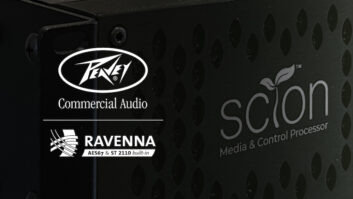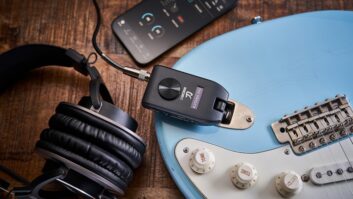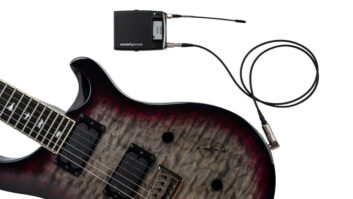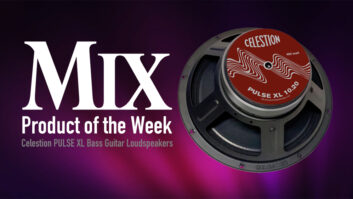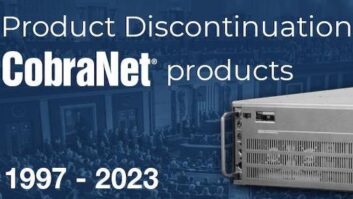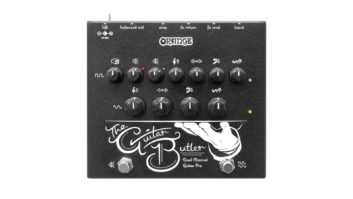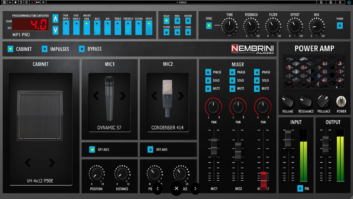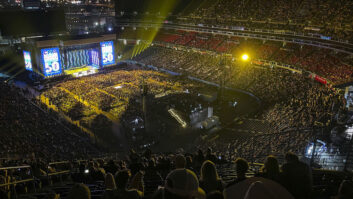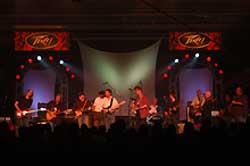
During the world debut of the Versarray line array at the International Dallas Guitar Festival (April 20 to 23, 2006), an esteemed artist lineup of Gary Hoey, Jerry Donahue and other legends positioned the Versarray system’s maiden performance on the indoor Peavey Stage as the centerpiece event of the festival. The stage measured 400 feet long and 160 feet wide, with a 20-foot flat ceiling (30 percent of the entire venue).
“The room was very difficult—concrete floor, concrete walls and a metal ceiling,” says Don Boomer, Peavey sound reinforcement product manager. “It was an airplane hangar, basically, with a
4.8-second delay time. That’s astronomical. You can’t get rid of that time; you have to make the system penetrate to the listener without bouncing back and forth off the surfaces.”
Boomer and Peavey audio veteran Ladd Temple began this task by powering a system of 16 dual ribbon-equipped Versarray 112 top boxes with Crest Audio Pro 9200 and Pro 5200 amplifiers. Two Versarray 218 subs supported the line arrays, and four QW 218 subs, bandpassed low and powered by four Crest Audio Pro 9200 amps, were added to control the power alley that ran down the center of the hall.
“We used a soft 2.5-degree curve between the upper six boxes in each line array and 5 degrees between the lower two boxes,” says Boomer. “Because of the ribbons’ true cylindrical projection, the ribbons work optimally at those angles. Smaller adjustments are simply unnecessary with a true line source array. The ribbons project as a flat, planar sound source; it’s a true column effect.”
With front of house at 75 feet in front of the stage, Boomer expected to calculate SPLs at around 100 from the 75,000-watt system. Front of house actually registered at 105 SPL, but without the listener fatigue associated with traditional loudspeaker designs. “The advantage of using the Versarray is not about ultimate loudness,” he says. “I can get loud with anything. It’s about control.”
The Versarray’s 0 to 15-degree bracket-and-pin adjustment, 90×15-degree (HxV) coverage pattern and numerous flying, mounting and stacking options provided much of the directional control. Added control of the dynamics came with the VSX 26 and VSX 48 loudspeaker-management processors, which the crew employed to help increase intelligibility while maintaining comfortable listening levels.
“The strength of the Versarray is being able to focus the sound,” explains Boomer, “and with the VSX’s ability to change the crossover points or the phase of some portion of the signal, we addressed the boxes separately and with little interference. We could measure for time and phase response, and we could use different filters for every adjustment: asymmetrical for the low cut and Linkwitz-Riley for the high cut, for example, and different slopes on each.”
The combination of Versarray and VSX also made the monitors much easier to control in the concert’s festival-style setup. Temple configured 12 bi-amped monitor mixes through a 40-channel Crest Audio console, each mix driven by a Peavey CS 1400 amp for the highs and a CS 4000 for the lows to accommodate up to 14 guitar players, two drummers, a bass player and a Hammond B3 at any given time. The VSX enabled him to make very subtle adjustments in
equalization and filtering to monitors as soundcheck lasted only long enough to make sure the guitar cables were plugged in.
“With analog filters, it’s ‘one size fits all,’” says Boomer, “but with the VSX, we’re able to custom-tailor each one. The side-fills behave differently than the floor monitors, and being able to adjust them independently is crucial. In just 12 rackspaces, we had all the power we needed for four separate bi-amped mixes. Each of our three monitor power racks could handle its own separate bi-amped, EQ’d mix and still fit in a small 12-rackspace case.”
To find out more, visit www.peavey.com.
